Related Research Articles
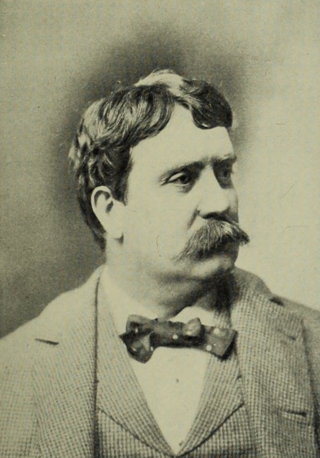
Daniel Hudson Burnham was an American architect and urban designer. A proponent of the Beaux-Arts movement, he may have been "the most successful power broker the American architectural profession has ever produced."

The World's Columbian Exposition, also known as the Chicago World's Fair, was a world's fair held in Chicago from May 5 to October 31, 1893, to celebrate the 400th anniversary of Christopher Columbus's arrival in the New World in 1492. The centerpiece of the Fair, held in Jackson Park, was a large water pool representing the voyage that Columbus took to the New World. Chicago won the right to host the fair over several competing cities, including New York City, Washington, D.C., and St. Louis. The exposition was an influential social and cultural event and had a profound effect on American architecture, the arts, American industrial optimism, and Chicago's image.

The Board of Trade is a British government body concerned with commerce and industry, currently within the Department for Business and Trade. Its full title is The Lords of the Committee of the Privy Council appointed for the consideration of all matters relating to Trade and Foreign Plantations, but is commonly known as the Board of Trade, and formerly known as the Lords of Trade and Plantations or Lords of Trade, and it has been a committee of the Privy Council of the United Kingdom. The board has gone through several evolutions, beginning with extensive involvement in colonial matters in the 17th century, to powerful regulatory functions in the Victorian Era and early 20th century. It was virtually dormant in the last third of the 20th century. In 2017, it was revitalised as an advisory board headed by the International Trade Secretary who has nominally held the title of President of the Board of Trade, and who at present is the only privy counsellor of the board, the other members of the present board filling roles as advisors.
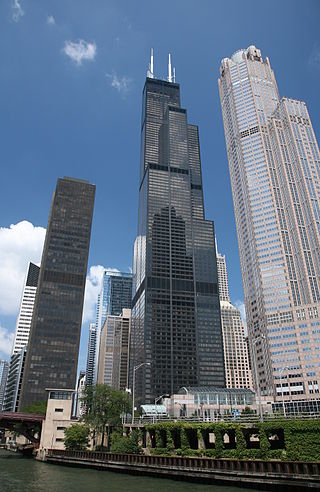
The buildings and architecture of Chicago reflect the city's history and multicultural heritage, featuring prominent buildings in a variety of styles. Most structures downtown were destroyed by the Great Chicago Fire in 1871.
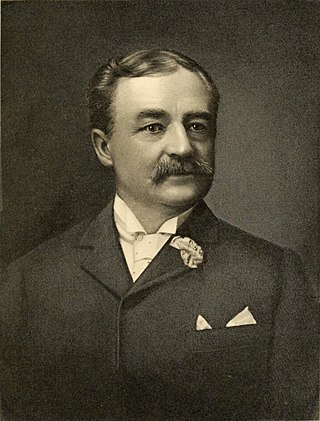
Aaron Montgomery Ward was an American entrepreneur based in Chicago who made his fortune through the use of mail order for retail sales of general merchandise to rural customers. In 1872 he founded Montgomery Ward & Company, which became nationally known.

Jules Guérin was an American muralist, architectural delineator, and illustrator. A painter and widely published magazine illustrator, he gained prominence for his architectural work such as in the 1906, Plan for Chicago, and for the large murals he painted in many well-known public structures such as the Lincoln Memorial.

John Graves Shedd was the second president, and chairman of the board, of Marshall Field & Company.

The Reliance Building is a skyscraper located at 1 W. Washington Street in the Loop community area of Chicago, Illinois. The first floor and basement were designed by John Root of the Burnham and Root architectural firm in 1890, with the rest of the building completed by Charles B. Atwood in 1895. It is the first skyscraper to have large plate glass windows make up the majority of its surface area, foreshadowing a design feature that would become dominant in the 20th century.

Willis Jefferson Polk was an American architect, best known for his work in San Francisco, California. For ten years, he was the West Coast representative of D.H. Burnham & Company. In 1915, Polk oversaw the architectural committee for the Panama–Pacific International Exposition (PPIE).
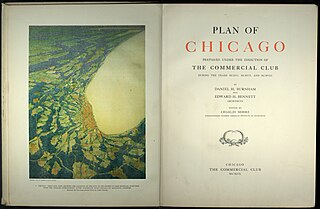
The Burnham Plan is a popular name for the 1909 Plan of Chicago coauthored by Daniel Burnham and Edward H. Bennett and published in 1909. It recommended an integrated series of projects including new and widened streets, parks, new railroad and harbor facilities, and civic buildings. Though only portions of the plan were realized, the document reshaped Chicago's central area and was an important influence on the new field of city planning.
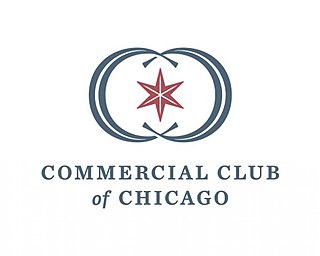
The Commercial Club of Chicago is a nonprofit 501(c)(4) social welfare organization founded in 1877 with a mission to promote the social and economic vitality of the metropolitan area of Chicago.

Charles Henry Wacker was an American businessman and philanthropist. He was vice chairman of the general committee of the Commercial Club of Chicago, and in 1909 was appointed chairman of the Chicago Plan Commission by Mayor Fred A. Busse. As commission chairman from 1909 to 1926, he championed the Burnham Plan for improving Chicago. His work to promote the plan included addresses, obtaining wide publicity from newspapers, and publishing Wacker's Manual of the Plan of Chicago as a textbook for local schoolchildren.

Washington Square, also known as Washington Square Park, is a park in Chicago, Illinois. A registered historic landmark that is better known by its nickname Bughouse Square, it was the most celebrated open air free-speech center in the country as well as a popular Chicago tourist attraction. It is located across Walton Street from Newberry Library at 901 N. Clark Street in the Near North Side community area of Chicago, Illinois, United States. It is Chicago's oldest existing small park. It is one of four Chicago Park District parks named after persons surnamed Washington. It was added to the National Register of Historic Places on May 20, 1991.
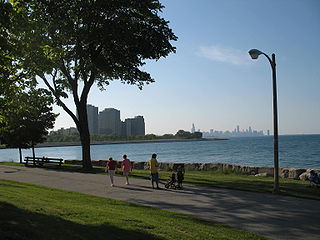
Burnham Park is a public park located in Chicago, Illinois. Situated along 6 miles (9.7 km) of Lake Michigan shoreline, the park connects Grant Park at 14th Street to Jackson Park at 56th Street. The 598 acres (242 ha) of parkland is owned and managed by the Chicago Park District. It was named for urban planner and architect Daniel Burnham in 1927. Burnham was one of the designers of the 1893 World's Columbian Exposition.

The American System-Built Homes were modest houses in a series designed by architect Frank Lloyd Wright. They were developed between 1911 and 1917 to fulfill his interest in affordable housing but were sold commercially for just 14 months. The Wright archives include 973 drawings and hundreds of reference materials, the largest collection of any of single Wright project. Wright cancelled the project in July 1917 by successfully suing his partner Arthur Richards for payments due and didn't speak of the program again. The designs were standardized and modular, so customers could choose from one hundred and twenty nine models on seven floorpans and three roof styles. Most materials were prepared and organized at Arthur Richards' lumber yard, so there was less waste and specialized labor needed for construction. Milled and marked materials were delivered to the work site for cutting and assembly by a carpenter. Windows, doors and some cabinetry were built at the yard. Frames, shelves, trim and some fixtures were cut and assembled on site. Every wood part had a part number and corresponding instructions and drawings for joining, fit and finish.

The Marshall Field and Company Building is a National Historic Landmark retail building on State Street in Chicago, Illinois. Now housing Macy's State Street, the Beaux-Arts and Commercial style complex was designed by architect Daniel Burnham and built in two stages—north end in 1901–02 and south end in 1905–06. It was the flagship location of the Marshall Field and Company and headquarters Marshall Field's chain of department stores. Since 2006, it is the main Chicago and midwestern location of the Macy's department stores. The building is located in the Chicago Loop area of the downtown central business district and it takes up the entire city block bounded clockwise from the west by North State Street, East Randolph Street, North Wabash Avenue, and East Washington Street. Field and partners founded their Chicago store in 1852, and first built an expansive shopping emporium on this site in 1868. The 1901 building was the fourth for the department store at this site.
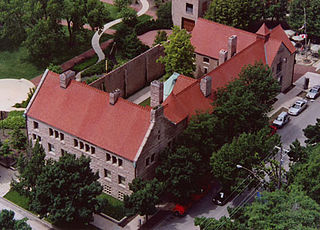
Prairie Avenue is a north–south street on the South Side of Chicago, which historically extended from 16th Street in the Near South Side to the city's southern limits and beyond. The street has a rich history from its origins as a major trail for horseback riders and carriages. During the last three decades of the 19th century, a six-block section of the street served as the residence of many of Chicago's elite families and an additional four-block section was also known for grand homes. The upper six-block section includes part of the historic Prairie Avenue District, which was declared a Chicago Landmark and added to the National Register of Historic Places.

Charles Moore (1855-1942) was an American journalist, historian and city planner.

SS John Mitchell was a steel-hulled, American lake freighter in service between 1907 and 1911. She was built in 1906 by the Great Lakes Engineering Works in St. Clair, Michigan, for the Cornell Steamship Company of Chicago, Illinois, which was managed by C.W. Elphicke. She entered service in 1907, and had a sister ship named William B. Davock. Throughout her career, John Mitchell carried iron ore and coal. On October 4, 1908, she ran aground at Indiana Harbor, Indiana, while loaded with iron ore.

The Burnham Plan of Manila is a popular name for Report on proposed improvements at Manila and Manila, P.I., plan of proposed improvements, a 1905 report and map by Daniel Burnham and Pierce Anderson which detail the plan for the city of Manila. It proposed developments based on the characteristics of the city and is patterned after the cities of Naples, Paris, and Venice.
References
- ↑ Merchants Club Executive Committee (1906). "Letter to Members of the Merchant's Club, 1906". Online Encyclopedia of Chicago. Historical Source. Chicago Historical Society.
- ↑ Merchants Club (1906). "Merchants Club Committee Minutes, 1906". Online Encyclopedia of Chicago. Historical Source. Chicago Historical Society.